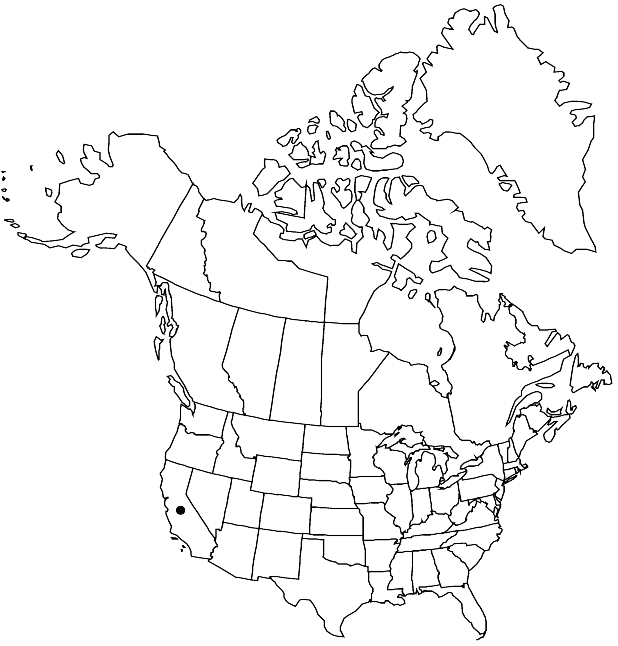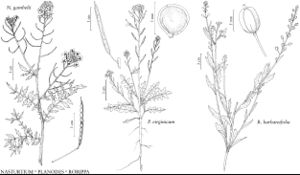Difference between revisions of "Nasturtium gambelii"
Bot. Jahrb. Syst. 66: 98. 1933.
FNA>Volume Importer |
FNA>Volume Importer |
||
| Line 30: | Line 30: | ||
|distribution=Calif.;Mexico (Chiapas;Federal District);Central America (Guatemala). | |distribution=Calif.;Mexico (Chiapas;Federal District);Central America (Guatemala). | ||
|discussion=<p>Of conservation concern.</p><!-- | |discussion=<p>Of conservation concern.</p><!-- | ||
| − | --><p>Nasturtium gambelii is known from southern California in Los Angeles, San Bernardino, San Luis Obispo, Santa Barbara, and Ventura counties. It is likely to be found also in undisturbed, freshwater habitats elsewhere in southern California and in Mexico and Central America. Intermediates between N. gambelii and N. officinale have been found in southern California, suggesting hybridization between them. Experimental work is needed to confirm this hypothesis.</p> | + | --><p><i>Nasturtium gambelii</i> is known from southern California in Los Angeles, San Bernardino, San Luis Obispo, Santa Barbara, and Ventura counties. It is likely to be found also in undisturbed, freshwater habitats elsewhere in southern California and in Mexico and Central America. Intermediates between <i>N. gambelii</i> and <i>N. officinale</i> have been found in southern California, suggesting hybridization between them. Experimental work is needed to confirm this hypothesis.</p> |
|tables= | |tables= | ||
|references= | |references= | ||
| Line 54: | Line 54: | ||
|publication year=1933 | |publication year=1933 | ||
|special status= | |special status= | ||
| − | |source xml=https://jpend@bitbucket.org/aafc-mbb/fna-data-curation.git/src/ | + | |source xml=https://jpend@bitbucket.org/aafc-mbb/fna-data-curation.git/src/8f726806613d60c220dc4493de13607dd3150896/coarse_grained_fna_xml/V7/V7_763.xml |
|tribe=Brassicaceae tribe Cardamineae | |tribe=Brassicaceae tribe Cardamineae | ||
|genus=Nasturtium | |genus=Nasturtium | ||
Revision as of 17:59, 18 September 2019
Plants sparsely to moderately pubescent. Stems 5–12 dm. Cauline leaves: petiole narrowly winged, base auriculate or not; blade 9–17-foliolate, 3–10 cm; lateral leaflets sessile, rachis narrowly winged, blade about same size as terminal; terminal leaflet blade linear to narrowly oblong or lanceolate, 0.5–2.5 cm × 2–8(–10) mm, base decurrent with adjacent pair of leaflets, margins often dentate, rarely sinuate-repand, apex acute. Fruiting pedicels divaricate or descending, straight, 9–25 mm. Flowers: sepals 3–4 × 1–1.5 mm; petals white, spatulate or oblanceolate, 6–8 × 2–2.5 mm, (base to 2 mm), apex obtuse to acute; filaments 5–7 mm; anthers 1–1.2 mm. Fruits 2–3 cm × 1–1.2 mm; ovules 24–40 per ovary; style 1–2.5 mm. Seeds uniseriate, reddish brown, ovate, 1–1.2 × 0.6–0.8 mm, minutely reticulate with 300–450 areolae on each side.
Phenology: Flowering May–Aug.
Habitat: Lake margins, streams, swamps, marshes, ponds
Elevation: 5-30 m
Distribution

Calif., Mexico (Chiapas, Federal District), Central America (Guatemala).
Discussion
Of conservation concern.
Nasturtium gambelii is known from southern California in Los Angeles, San Bernardino, San Luis Obispo, Santa Barbara, and Ventura counties. It is likely to be found also in undisturbed, freshwater habitats elsewhere in southern California and in Mexico and Central America. Intermediates between N. gambelii and N. officinale have been found in southern California, suggesting hybridization between them. Experimental work is needed to confirm this hypothesis.
Selected References
None.
